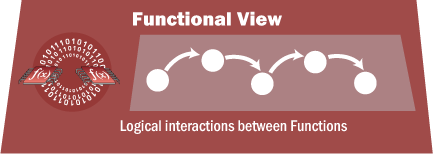Functional Viewpoint

The Functional Viewpoint addresses the analysis of abstract functional elements and their logical interactions rather than engineering concerns of how functions are implemented, where they are allocated, how they transfer information, which protocols are used, and what method is used to implement them.
The Functional Viewpoint of the CVRIA focuses on the behavior, structure, and interaction of the functions performed within the connected vehicle environment.
The behavior of a Function (aka Process) is the set of actions performed by this element to achieve an objective. A Process performs actions to achieve an application objective or to support actions of another Process. This may involve data collection, data transformation, data generation, data generation or processing in performing those actions. Functional Views define Processes to control and manage system behavior, such as monitoring, and other active control elements that are part of describing the functional behavior of the system. They also describe data processing functions, data stores and the logical flows of information among these elements.
The Functional Viewpoint is modeled using a Structure Analysis methodology, based on the work of Hatley/Pirbhai. The Functional View leverages the existing National ITS Architecture's Logical Architecture as the starting point and defines collections of processes and the data that flows between the processes. Each process is documented in a Process Specification (PSpec) and is traced to one or more connected vehicle requirements.